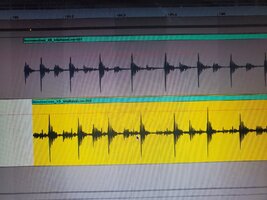1980 Special Twin
XS650 Enthusiast
So I make industrial techno music using motorcycle samples. I've been meaning to post them and will soon. I use different bikes and have used the XS in the past, but I was excited to finally make some quality recordings of my 1980 xs650 with shorty mufflers. I don't believe it has been re-phased at all. I sync'd it with a homemade manometer, and although the tool didn't operate all that smoothly the bike seems to perform well.
My understanding of a paralell twin was that both cylinders fire at once. If that is the case, why do the left and right channels appear to fire differently? The left on top seems to fire a moment before the right. There is no fault in the recording gear or software.
Do I misunderstand the operation of the twin?
My understanding of a paralell twin was that both cylinders fire at once. If that is the case, why do the left and right channels appear to fire differently? The left on top seems to fire a moment before the right. There is no fault in the recording gear or software.
Do I misunderstand the operation of the twin?


